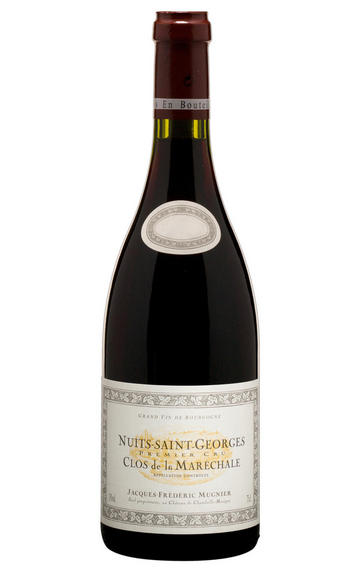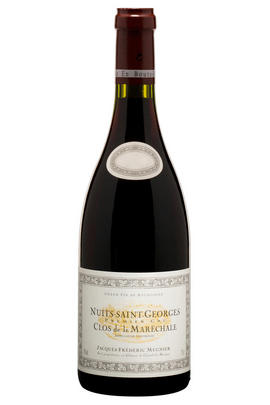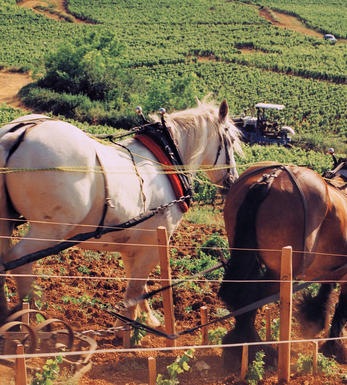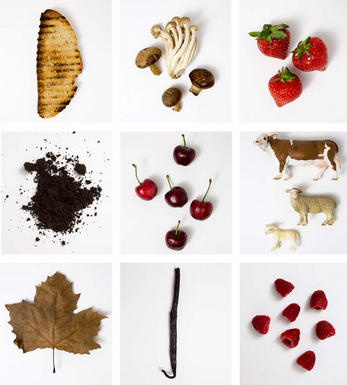
2011 Nuits-St Georges Rouge, Clos de la Maréchale, 1er Cru,Jacques-Frédéric Mugnier, Burgundy

Critics reviews
(Allen Meadows - burghound.com)
Neal Martin - 30/10/2013
Jancis Robinson, Julia Harding MW & Richard Hemming - jancisrobinson.com - Jan 2013
About this WINE

Domaine Jacques-Frederic Mugnier
Domaine Jacques-Frédéric Mugnier is based at the Château de Chambolle-Musigny, which has been in the Mugnier family since 1863. Frédéric Mugnier – the fifth generation of the family on the property – took over in 1985. As of 2004, he has reclaimed the Nuits-St Georges Clos de la Maréchale vineyard, which had been on lease to Faiveley since 1950.

Nuits-Saint Georges
Originally known as Nuits, or even Nuits-sous-Beaune, the town was happy to add the name of its finest vineyard, Les St Georges, in the 19th century. There are no Grands Crus, but many fine Premier Cru vineyards, the mayor of the time – Henri Gouges – preferring not to single out any vineyard for the highest status.
The wines of Nuits-St Georges vary according to their exact provenance. Those of the hamlet of Prémeaux, considered to be part of Nuits-St Georges for viticultural purposes, are often on the lighter side.The richest and most sought-after are those just south of Nuits-St Georges such as Les Vaucrains, Les Cailles and Les St Georges itself. The third sector, including Les Murgers, Les Damodes and Les Boudots are at the Vosne-Romanée end of the village, and demonstrate some of the extra finesse associated with Vosne.
Several domaines (Gouges, Rion, Arlot) now produce a white Nuits-St Georges from Pinot Blanc or Chardonnay.
- 175 hectares of village Nuits-St Georges
- 143 hectares of Premier Cru vineyards (20 in all). Best vineyards include Les St Georges, and Clos des Argillières and Clos de la Maréchale in Prémeaux
- Recommended producers: Gouges, Rion, Liger Belair, Potel
- Recommended restaurant : La Cabotte (small but stylish)

Pinot Noir
Pinot Noir is probably the most frustrating, and at times infuriating, wine grape in the world. However when it is successful, it can produce some of the most sublime wines known to man. This thin-skinned grape which grows in small, tight bunches performs well on well-drained, deepish limestone based subsoils as are found on Burgundy's Côte d'Or.
Pinot Noir is more susceptible than other varieties to over cropping - concentration and varietal character disappear rapidly if yields are excessive and yields as little as 25hl/ha are the norm for some climats of the Côte d`Or.
Because of the thinness of the skins, Pinot Noir wines are lighter in colour, body and tannins. However the best wines have grip, complexity and an intensity of fruit seldom found in wine from other grapes. Young Pinot Noir can smell almost sweet, redolent with freshly crushed raspberries, cherries and redcurrants. When mature, the best wines develop a sensuous, silky mouth feel with the fruit flavours deepening and gamey "sous-bois" nuances emerging.
The best examples are still found in Burgundy, although Pinot Noir`s key role in Champagne should not be forgotten. It is grown throughout the world with notable success in the Carneros and Russian River Valley districts of California, and the Martinborough and Central Otago regions of New Zealand.


Buying options
Add to wishlist
Description
This is another beautiful wine in Frédéric Mugnier’s refined style. It is really gracious with superbly succulent and seductive fruit on the nose, followed by a very long mouthful of silky fruit with interwoven threads of red and black.
Jasper Morris MW, Berrys' Burgundy Director “I refuse absolutely to harvest in August” said Freddy Mugnier while thinking about the upcoming vendanges. In fact he began on 2nd September and has brought in some very fine wines in 2011, a vintage which pleases him for its elegance, balance and harmony. Once again all the wine has qualified for the main Clos de la Maréchale label.
wine at a glance
Delivery and quality guarantee